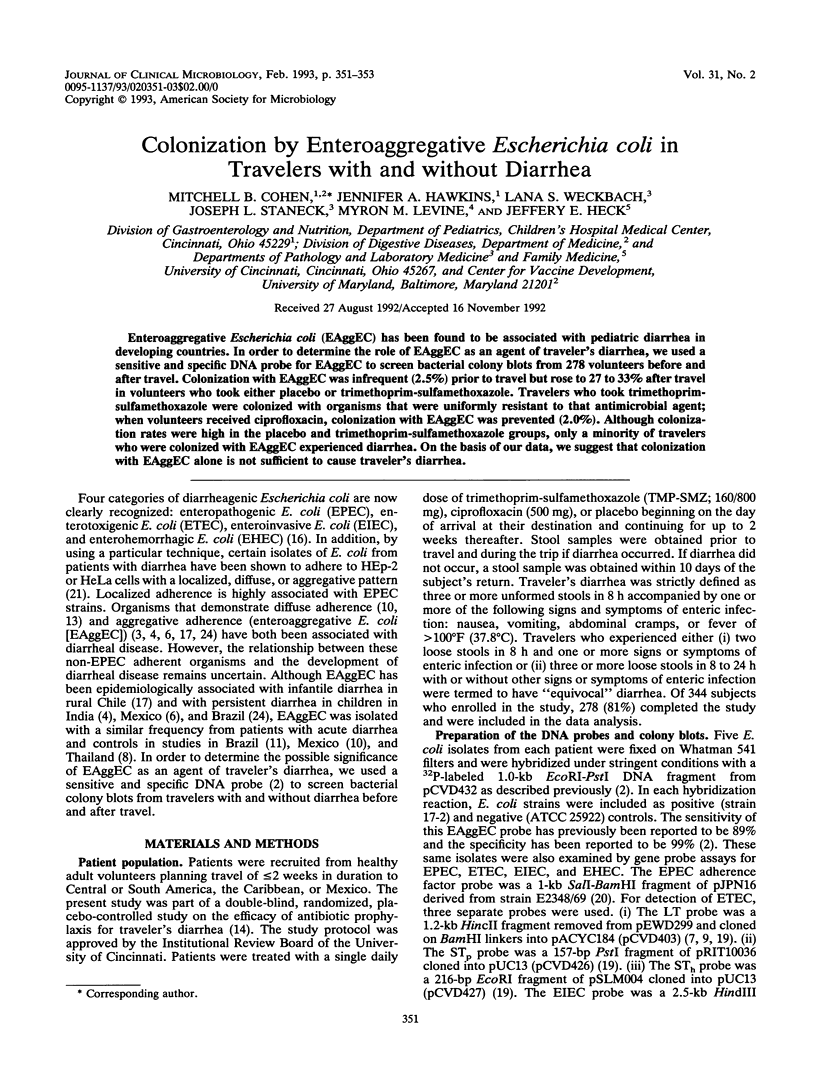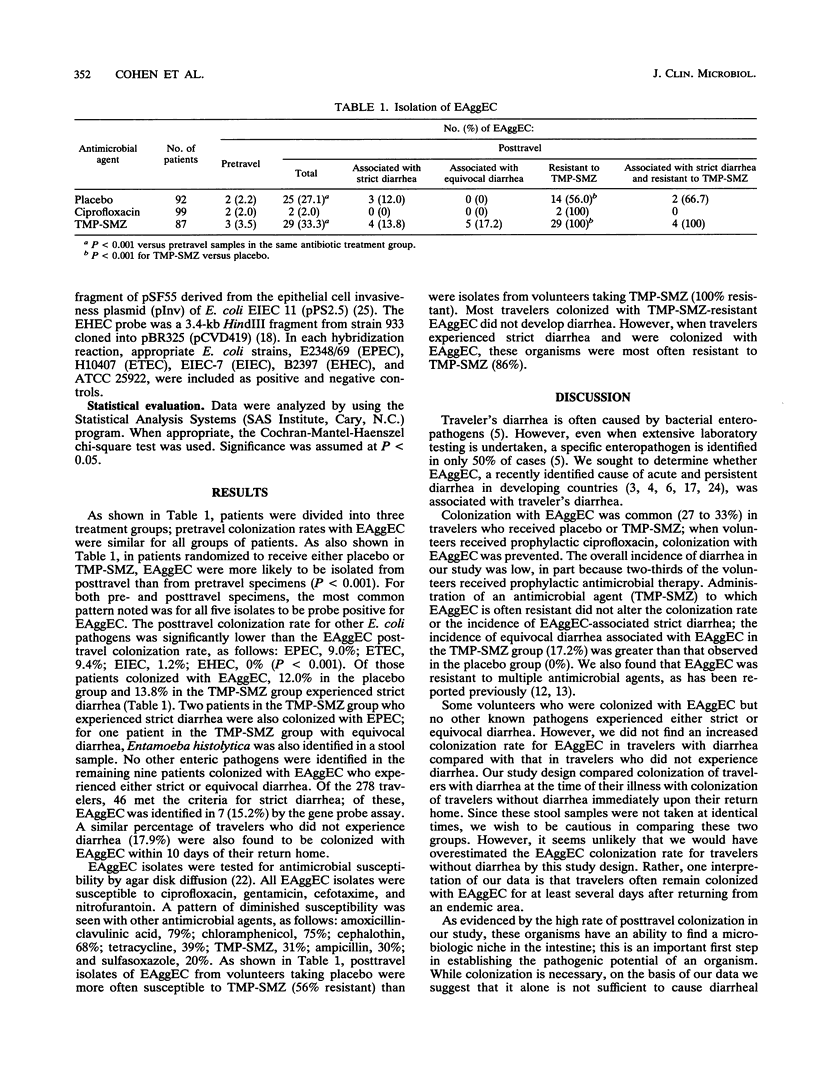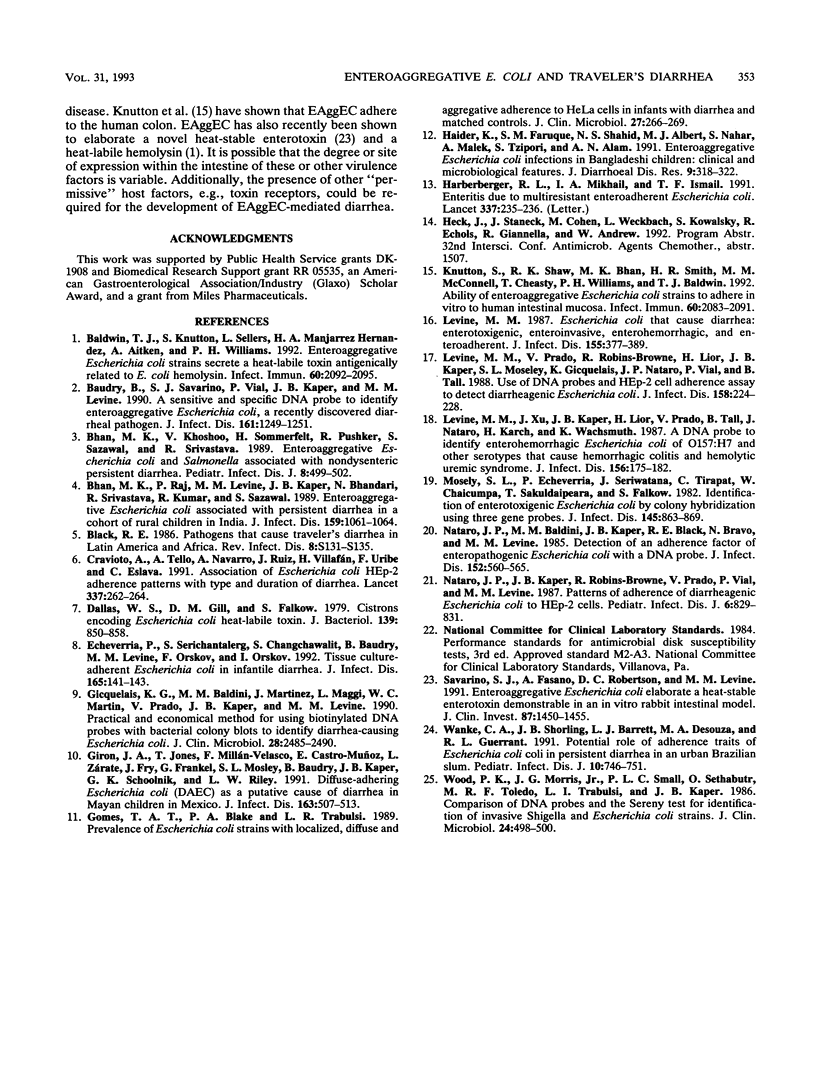Abstract
Enteroaggregative Escherichia coli (EAggEC) has been found to be associated with pediatric diarrhea in developing countries. In order to determine the role of EAggEC as an agent of traveler's diarrhea, we used a sensitive and specific DNA probe for EAggEC to screen bacterial colony blots from 278 volunteers before and after travel. Colonization with EAggEC was infrequent (2.5%) prior to travel but rose to 27 to 33% after travel in volunteers who took either placebo or trimethoprim-sulfamethoxazole. Travelers who took trimethoprimsulfamethoxazole were colonized with organisms that were uniformly resistant to that antimicrobial agent; when volunteers received ciprofloxacin, colonization with EAggEC was prevented (2.0%). Although colonization rates were high in the placebo and trimethoprim-sulfamethoxazole groups, only a minority of travelers who were colonized with EAggEC experienced diarrhea. On the basis of our data, we suggest that colonization with EAggEC alone is not sufficient to cause traveler's diarrhea.
Full text
PDF


Selected References
These references are in PubMed. This may not be the complete list of references from this article.
- Baldwin T. J., Knutton S., Sellers L., Hernandez H. A., Aitken A., Williams P. H. Enteroaggregative Escherichia coli strains secrete a heat-labile toxin antigenically related to E. coli hemolysin. Infect Immun. 1992 May;60(5):2092–2095. doi: 10.1128/iai.60.5.2092-2095.1992. [DOI] [PMC free article] [PubMed] [Google Scholar]
- Baudry B., Savarino S. J., Vial P., Kaper J. B., Levine M. M. A sensitive and specific DNA probe to identify enteroaggregative Escherichia coli, a recently discovered diarrheal pathogen. J Infect Dis. 1990 Jun;161(6):1249–1251. doi: 10.1093/infdis/161.6.1249. [DOI] [PubMed] [Google Scholar]
- Bhan M. K., Khoshoo V., Sommerfelt H., Raj P., Sazawal S., Srivastava R. Enteroaggregative Escherichia coli and Salmonella associated with nondysenteric persistent diarrhea. Pediatr Infect Dis J. 1989 Aug;8(8):499–502. doi: 10.1097/00006454-198908000-00005. [DOI] [PubMed] [Google Scholar]
- Bhan M. K., Raj P., Levine M. M., Kaper J. B., Bhandari N., Srivastava R., Kumar R., Sazawal S. Enteroaggregative Escherichia coli associated with persistent diarrhea in a cohort of rural children in India. J Infect Dis. 1989 Jun;159(6):1061–1064. doi: 10.1093/infdis/159.6.1061. [DOI] [PubMed] [Google Scholar]
- Black R. E. Pathogens that cause travelers' diarrhea in Latin America and Africa. Rev Infect Dis. 1986 May-Jun;8 (Suppl 2):S131–S135. doi: 10.1093/clinids/8.Supplement_2.S131. [DOI] [PMC free article] [PubMed] [Google Scholar]
- Cravioto A., Tello A., Navarro A., Ruiz J., Villafán H., Uribe F., Eslava C. Association of Escherichia coli HEp-2 adherence patterns with type and duration of diarrhoea. Lancet. 1991 Feb 2;337(8736):262–264. doi: 10.1016/0140-6736(91)90868-p. [DOI] [PubMed] [Google Scholar]
- Dallas W. S., Gill D. M., Falkow S. Cistrons encoding Escherichia coli heat-labile toxin. J Bacteriol. 1979 Sep;139(3):850–858. doi: 10.1128/jb.139.3.850-858.1979. [DOI] [PMC free article] [PubMed] [Google Scholar]
- Echeverria P., Serichantalerg O., Changchawalit S., Baudry B., Levine M. M., Orskov F., Orskov I. Tissue culture-adherent Escherichia coli in infantile diarrhea. J Infect Dis. 1992 Jan;165(1):141–143. doi: 10.1093/infdis/165.1.141. [DOI] [PubMed] [Google Scholar]
- Gicquelais K. G., Baldini M. M., Martinez J., Maggi L., Martin W. C., Prado V., Kaper J. B., Levine M. M. Practical and economical method for using biotinylated DNA probes with bacterial colony blots to identify diarrhea-causing Escherichia coli. J Clin Microbiol. 1990 Nov;28(11):2485–2490. doi: 10.1128/jcm.28.11.2485-2490.1990. [DOI] [PMC free article] [PubMed] [Google Scholar]
- Girón J. A., Jones T., Millán-Velasco F., Castro-Muñoz E., Zárate L., Fry J., Frankel G., Moseley S. L., Baudry B., Kaper J. B. Diffuse-adhering Escherichia coli (DAEC) as a putative cause of diarrhea in Mayan children in Mexico. J Infect Dis. 1991 Mar;163(3):507–513. doi: 10.1093/infdis/163.3.507. [DOI] [PubMed] [Google Scholar]
- Gomes T. A., Blake P. A., Trabulsi L. R. Prevalence of Escherichia coli strains with localized, diffuse, and aggregative adherence to HeLa cells in infants with diarrhea and matched controls. J Clin Microbiol. 1989 Feb;27(2):266–269. doi: 10.1128/jcm.27.2.266-269.1989. [DOI] [PMC free article] [PubMed] [Google Scholar]
- Haberberger R. L., Jr, Mikhail I. A., Ismail T. F. Enteritis due to multiresistant enteroadherent Escherichia coli. Lancet. 1991 Jan 26;337(8735):235–236. doi: 10.1016/0140-6736(91)92197-a. [DOI] [PubMed] [Google Scholar]
- Haider K., Faruque S. M., Shahid N. S., Albert M. J., Nahar S., Malek A., Tzipori S., Alam A. N. Enteroaggregative Escherichia coli infections in Bangladeshi children: clinical and microbiological features. J Diarrhoeal Dis Res. 1991 Dec;9(4):318–322. [PubMed] [Google Scholar]
- Knutton S., Shaw R. K., Bhan M. K., Smith H. R., McConnell M. M., Cheasty T., Williams P. H., Baldwin T. J. Ability of enteroaggregative Escherichia coli strains to adhere in vitro to human intestinal mucosa. Infect Immun. 1992 May;60(5):2083–2091. doi: 10.1128/iai.60.5.2083-2091.1992. [DOI] [PMC free article] [PubMed] [Google Scholar]
- Levine M. M. Escherichia coli that cause diarrhea: enterotoxigenic, enteropathogenic, enteroinvasive, enterohemorrhagic, and enteroadherent. J Infect Dis. 1987 Mar;155(3):377–389. doi: 10.1093/infdis/155.3.377. [DOI] [PubMed] [Google Scholar]
- Levine M. M., Prado V., Robins-Browne R., Lior H., Kaper J. B., Moseley S. L., Gicquelais K., Nataro J. P., Vial P., Tall B. Use of DNA probes and HEp-2 cell adherence assay to detect diarrheagenic Escherichia coli. J Infect Dis. 1988 Jul;158(1):224–228. doi: 10.1093/infdis/158.1.224. [DOI] [PubMed] [Google Scholar]
- Levine M. M., Xu J. G., Kaper J. B., Lior H., Prado V., Tall B., Nataro J., Karch H., Wachsmuth K. A DNA probe to identify enterohemorrhagic Escherichia coli of O157:H7 and other serotypes that cause hemorrhagic colitis and hemolytic uremic syndrome. J Infect Dis. 1987 Jul;156(1):175–182. doi: 10.1093/infdis/156.1.175. [DOI] [PubMed] [Google Scholar]
- Moseley S. L., Echeverria P., Seriwatana J., Tirapat C., Chaicumpa W., Sakuldaipeara T., Falkow S. Identification of enterotoxigenic Escherichia coli by colony hybridization using three enterotoxin gene probes. J Infect Dis. 1982 Jun;145(6):863–869. doi: 10.1093/infdis/145.6.863. [DOI] [PubMed] [Google Scholar]
- Nataro J. P., Baldini M. M., Kaper J. B., Black R. E., Bravo N., Levine M. M. Detection of an adherence factor of enteropathogenic Escherichia coli with a DNA probe. J Infect Dis. 1985 Sep;152(3):560–565. doi: 10.1093/infdis/152.3.560. [DOI] [PubMed] [Google Scholar]
- Nataro J. P., Kaper J. B., Robins-Browne R., Prado V., Vial P., Levine M. M. Patterns of adherence of diarrheagenic Escherichia coli to HEp-2 cells. Pediatr Infect Dis J. 1987 Sep;6(9):829–831. doi: 10.1097/00006454-198709000-00008. [DOI] [PubMed] [Google Scholar]
- Savarino S. J., Fasano A., Robertson D. C., Levine M. M. Enteroaggregative Escherichia coli elaborate a heat-stable enterotoxin demonstrable in an in vitro rabbit intestinal model. J Clin Invest. 1991 Apr;87(4):1450–1455. doi: 10.1172/JCI115151. [DOI] [PMC free article] [PubMed] [Google Scholar]
- Wanke C. A., Schorling J. B., Barrett L. J., Desouza M. A., Guerrant R. L. Potential role of adherence traits of Escherichia coli in persistent diarrhea in an urban Brazilian slum. Pediatr Infect Dis J. 1991 Oct;10(10):746–751. doi: 10.1097/00006454-199110000-00006. [DOI] [PubMed] [Google Scholar]
- Wood P. K., Morris J. G., Jr, Small P. L., Sethabutr O., Toledo M. R., Trabulsi L., Kaper J. B. Comparison of DNA probes and the Sereny test for identification of invasive Shigella and Escherichia coli strains. J Clin Microbiol. 1986 Sep;24(3):498–500. doi: 10.1128/jcm.24.3.498-500.1986. [DOI] [PMC free article] [PubMed] [Google Scholar]


